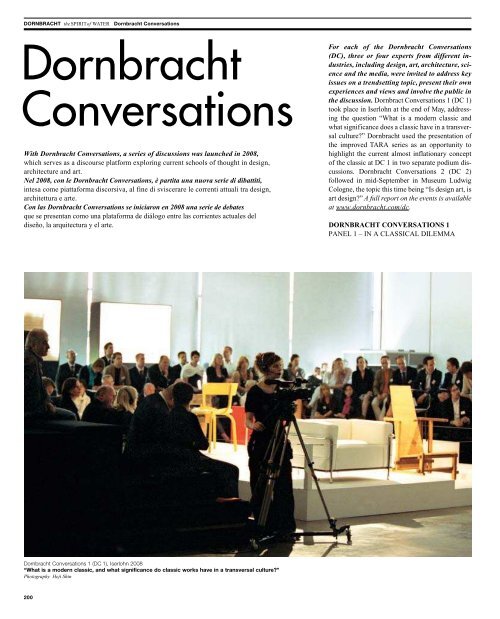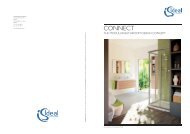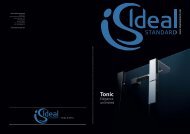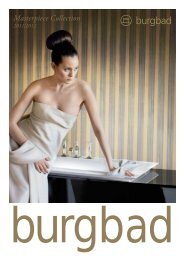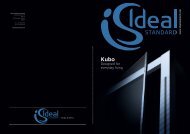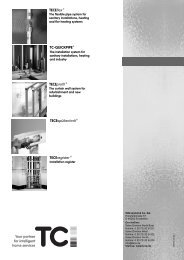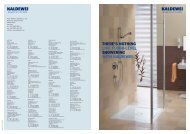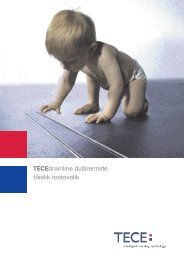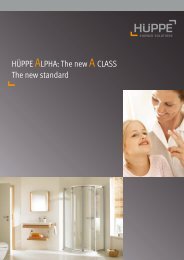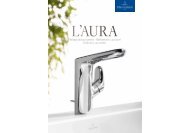productos Dornbracht
productos Dornbracht
productos Dornbracht
You also want an ePaper? Increase the reach of your titles
YUMPU automatically turns print PDFs into web optimized ePapers that Google loves.
DORNBRACHT the SPIRITof WATER <strong>Dornbracht</strong> Conversations<br />
DORNBRACHT the SPIRITof WATER <strong>Dornbracht</strong> Conversations<br />
<strong>Dornbracht</strong><br />
Conversations<br />
With <strong>Dornbracht</strong> Conversations, a series of discussions was launched in 2008,<br />
which serves as a discourse platform exploring current schools of thought in design,<br />
architecture and art.<br />
Nel 2008, con le <strong>Dornbracht</strong> Conversations, è partita una nuova serie di dibattiti,<br />
intesa come piattaforma discorsiva, al fine di sviscerare le correnti attuali tra design,<br />
architettura e arte.<br />
Con las <strong>Dornbracht</strong> Conversations se iniciaron en 2008 una serie de debates<br />
que se presentan como una plataforma de diálogo entre las corrientes actuales del<br />
diseño, la arquitectura y el arte.<br />
<strong>Dornbracht</strong> Conversations 1 (DC 1), Iserlohn 2008<br />
“What is a modern classic, and what significance do classic works have in a transversal culture?”<br />
Photography Heji Shin<br />
For each of the <strong>Dornbracht</strong> Conversations<br />
(DC), three or four experts from different industries,<br />
including design, art, architecture, science<br />
and the media, were invited to address key<br />
issues on a trendsetting topic, present their own<br />
experiences and views and involve the public in<br />
the discussion. Dornbract Conversations 1 (DC 1)<br />
took place in Iserlohn at the end of May, addressing<br />
the question “What is a modern classic and<br />
what significance does a classic have in a transversal<br />
culture?” <strong>Dornbracht</strong> used the presentation of<br />
the improved TARA series as an opportunity to<br />
highlight the current almost inflationary concept<br />
of the classic at DC 1 in two separate podium discussions.<br />
<strong>Dornbracht</strong> Conversations 2 (DC 2)<br />
followed in mid-September in Museum Ludwig<br />
Cologne, the topic this time being “Is design art, is<br />
art design?” A full report on the events is available<br />
at www.dornbracht.com/dc.<br />
<strong>Dornbracht</strong> Conversations 1<br />
PANEL 1 – IN A CLASSICAL DILEMMA<br />
“What exactly is a classic?”<br />
“A classic is something that feels as if it has always<br />
been there. A classic is a “déjà vu” experience, as it<br />
were.” (Tobias Rehberger)<br />
“Classics are only relevant for me if I am working<br />
with a company. Only then, as in the case of Thonet,<br />
are classic products relevant. They help me to understand<br />
the essence of the company.” (Stefan Diez)<br />
“Classics are a matter of definition and definitions<br />
are determined by the media. Ironically, the creators<br />
themselves had anything but a classic in mind when<br />
creating their product.” (Gerda Breuer)<br />
“These days, if nothing else, classics have a meaningful<br />
function. We live in an eclectic society. For<br />
that reason, we need anchor points that we can hook<br />
onto.” (Sophie Lovell)<br />
“Are classics a good thing?<br />
Do we need classics?”<br />
“Design classics constrain young people. They<br />
should be creating new examples instead of focusing<br />
on things that are virtually antiques today.”<br />
(Gerda Breuer)<br />
“Classics are a guarantee per se, a proven concept.<br />
That is why designers these days have to create<br />
many things that look like classics. However, the<br />
sentimentality frequently associated with classics<br />
is a bad thing. It often proliferates as kitsch – one<br />
negative example being the new Beetle: it lives up<br />
to the legend of the original Beetle, without going<br />
beyond the status of being a plaything. That’s<br />
awful.” (Stefan Diez)<br />
PANEL 2 – GENERATION CHANGE<br />
Improvements to the design icon TARA simultaneously<br />
herald a new generation: the TARA design<br />
from 1992 was created by Dieter Sieger, with the<br />
improved TARA being designed by his son Michael.<br />
A good reason to talk to father and son about the<br />
value of a classic. On their side: Andreas <strong>Dornbracht</strong><br />
and Mike Meiré. Everyone in the discussion<br />
agreed that archetypes like TARA stand for qualities<br />
that have withstood the test of time. They give direction,<br />
clarity and guarantee security. The improved<br />
TARA brings the classic up-to-date. TARA has become<br />
more slender, while losing none of its character.<br />
The modifications are only in the detail.<br />
“What makes TARA a classic?”<br />
“TARA is very elegant and, at the same time,<br />
timeless.” (Dieter Sieger)<br />
“TARA exhibits many features of an archetype.<br />
Children’s books often depict taps with crossed handles<br />
and tubular spouts. That is why a lot of people<br />
felt with TARA that they had already seen something<br />
like it before, so they immediately felt comfortable<br />
with the product.” (Andreas <strong>Dornbracht</strong>)<br />
“With TARA, <strong>Dornbracht</strong> introduced a new kind<br />
of fitting – a designer fitting. The fact that TARA<br />
has been copied so many times around the world<br />
<strong>Dornbracht</strong> Conversations 1 (DC 1), Iserlohn 2008<br />
Accompanying “Design classics” exhibition<br />
Photography Heji Shin<br />
is testimony to its relevance.” (Michael Sieger)<br />
“People can sometimes live for ten, twenty or<br />
even thirty years with a fitting like TARA. It has<br />
a timeless quality.” (Mike Meiré)<br />
“Should we make any changes at all<br />
to a classic like TARA?”<br />
“When you have an iconic product like TARA, you<br />
have to do something to enable it to become and<br />
remain a classic. And that includes bringing something<br />
new into the market every now and then.”<br />
(Andreas <strong>Dornbracht</strong>)<br />
“TARA is a brand like Nivea or Maggi that is actually<br />
constantly being improved. It involves immensely<br />
detailed work which is barely noticeable<br />
to the man in the street.” (Dieter Sieger)<br />
“TARA was introduced as a single-hole mixer,<br />
now it has a complete range including free-standing<br />
fittings for bathtubs. Even with these additional<br />
products, we naturally continue to work on the<br />
classic.” (Michael Sieger)<br />
<strong>Dornbracht</strong> Conversations 2<br />
IS DESIGN ART, IS ART DESIGN?<br />
The artist Tobias Rehberger, Konstantin Grcic, currently<br />
Germany’s most successful industrial designer,<br />
Mike Meiré as the “interface” between art<br />
and design, and collector Harold Falckenberg held<br />
a captivating discussion on the aspects which unite<br />
or divide the disciplines of art and design. This<br />
time, <strong>Dornbracht</strong> invited its guests to the Museum<br />
Ludwig in Cologne. The installation known as “The<br />
chicken-and-egg-no-problem wallpainting” created<br />
by Tobias Rehberger and sponsored by <strong>Dornbracht</strong><br />
was being exhibited until the end of September.<br />
“Where are the boundaries between art<br />
and design?”<br />
“These days, many design pieces sell for practically<br />
as much as art works.” (Katia Baudin)<br />
“For me, both design and art are simply a matter of<br />
perspective. Depending on its scope of use, a<br />
“thing” either has a purpose or not. I don’t think<br />
there is a difference that has to be externally identifiable.”<br />
(Tobias Rehberger)<br />
“I consider perspective during the creation process<br />
to be relevant to the decision: what is my perspective,<br />
my motive as the creator? Do I want to design<br />
an industrial product or create a work of art? Both<br />
can ultimately lead to the same result, but with completely<br />
different connotations.” (Konstantin Grcic)<br />
“In principle, design is functionally created, whereas<br />
in principle, art is autonomously created.”<br />
(Harald Falckenberg)<br />
“At the end of the day, whether design or art, it<br />
boils down to: what you do ultimately – hopefully –<br />
has some relevance.” (Mike Meiré)<br />
“And at what point do art and design meet?”<br />
“For me, there is no merging or fusion between<br />
views. Just because a sculpture looks like a chair,<br />
does it automatically have nothing to do with<br />
design? Does it have little to do with design, just<br />
because it is used like a chair?” (Tobias Rehberger)<br />
“I think design definitely has a place in a museum,<br />
but not because by being in a museum it becomes<br />
art.” (Konstantin Grcic)<br />
“I think, it is in the perception of the term ‘creator’<br />
where art and design meet.”<br />
(Harald Falckenberg)<br />
“What we are coming to realize is that design and<br />
art have become a lifestyle factor.” (Mike Meiré)<br />
200<br />
201


